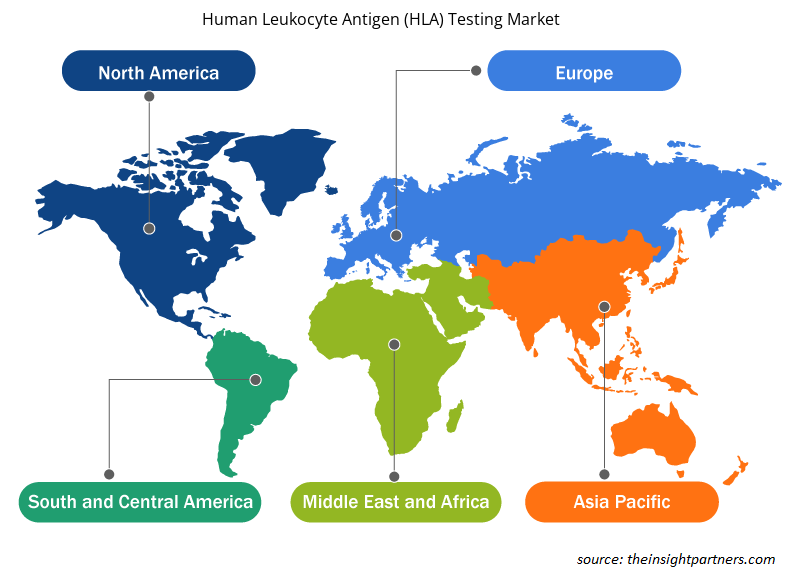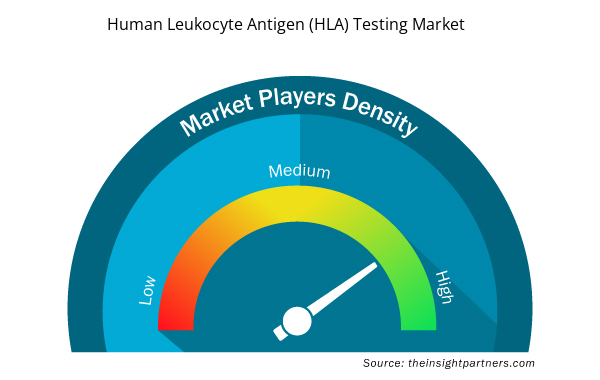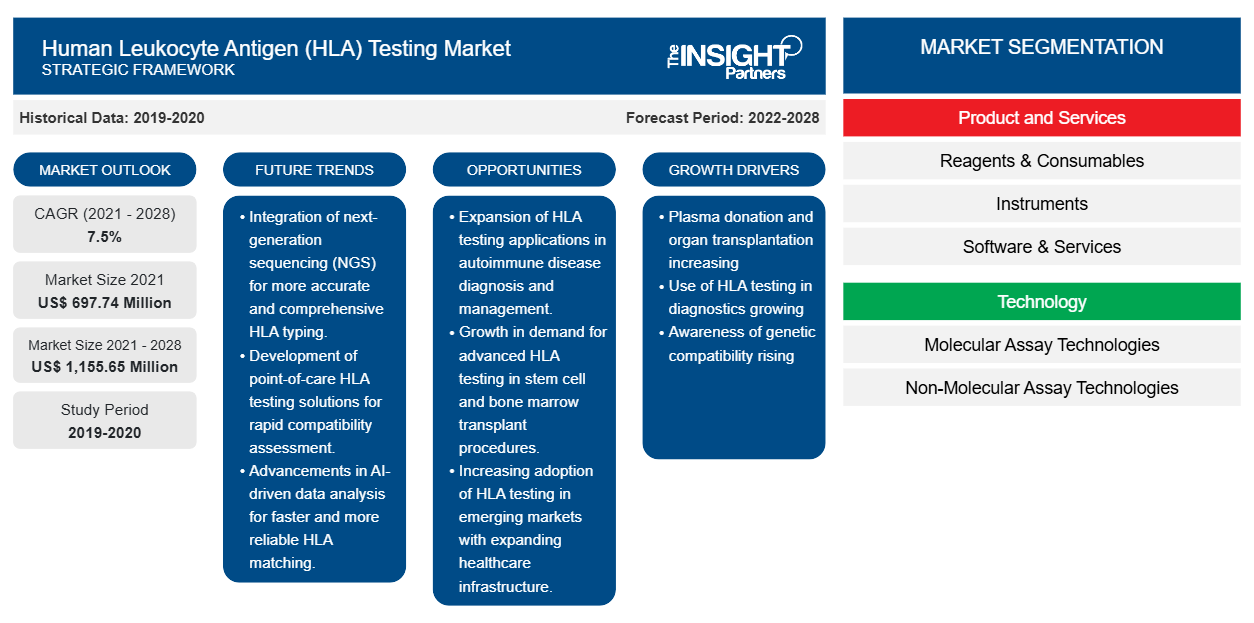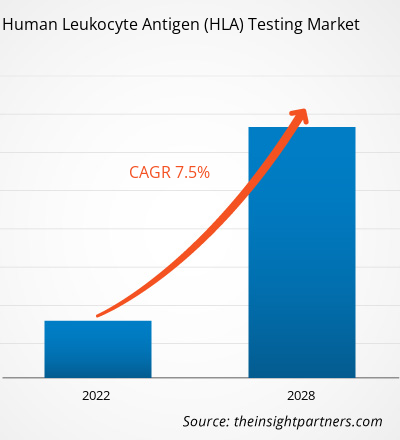Si prevede che il mercato dei test dell'antigene leucocitario umano (HLA) raggiungerà 1.155,65 milioni di dollari entro il 2028, rispetto ai 697,74 milioni di dollari del 2021; si prevede che registrerà un CAGR del 7,5% dal 2022 al 2028.
Gli antigeni leucocitari umani svolgono una parte essenziale nella risposta immunitaria del corpo alle sostanze esterne. L'uso principale del test HLA è quello di abbinare i riceventi di trapianto di organi e tessuti con donatori compatibili. Il test HLA comporta anche lo screening dei riceventi di trapianto per la presenza di anticorpi che potrebbero colpire il tessuto o l'organo donato come parte di una risposta immunitaria.
Il rapporto offre approfondimenti e analisi approfondite del mercato dei test dell'antigene leucocitario umano (HLA), sottolineando tra gli altri le tendenze di mercato, i progressi tecnologici e le dinamiche di mercato. Fornisce inoltre l'analisi del panorama competitivo dei principali attori del mercato a livello mondiale. Inoltre, include l'impatto della pandemia di COVID-19 sul mercato in tutte le principali regioni. La pandemia di COVID-19 ha creato sia una crisi di salute pubblica che una crisi economica in tutto il mondo. Prima della pandemia, il mercato dei test dell'antigene leucocitario umano (HLA) era in continua crescita grazie alla regolarità nella valutazione dei donatori di organi, delle consolazioni e dei trattamenti. La prima ondata di COVID-19 ha interrotto le consultazioni, i follow-up e gli screening correlati a malattie diverse dal COVID-19. Diverse aziende hanno subito gravi perdite nell'ultimo trimestre del 2019; la pandemia ha avuto in particolare effetti negativi sul mercato globale nel primo e nel secondo trimestre del 2020. Le aziende in tutto il mondo sono state ostacolate a causa dell'interruzione delle catene di fornitura e dell'aumento della domanda di prodotti e servizi sanitari. Per ridurre l'infezione da COVID-19 negli ospedali e nelle cliniche, gli operatori sanitari e i pazienti hanno adottato e preferito curare i loro pazienti da remoto. Queste circostanze imprevedibili hanno anche ostacolato le procedure di trapianto di organi. Molti trattamenti chirurgici e visite non urgenti sono stati annullati o posticipati e gli interventi chirurgici elettivi sono stati sospesi in molte istituzioni per limitare la diffusione del SARS-CoV-2 e per riservare e riallocare risorse, tra cui personale sanitario (infermieri e anestesisti), attrezzature mediche (dispositivi di protezione individuale e ventilatori) e posti letto. La raccomandazione di "restare a casa" ha portato a una significativa riduzione delle donazioni di organi e degli interventi chirurgici di trapianto di organi. Queste condizioni hanno frenato la crescita del mercato dei test dell'antigene leucocitario umano (HLA) in tutto il mondo nel 2020.
Personalizza questo report in base alle tue esigenze
Riceverai la personalizzazione gratuita di qualsiasi report, comprese parti di questo report, o analisi a livello nazionale, pacchetto dati Excel, oltre a usufruire di grandi offerte e sconti per start-up e università
- Scopri le principali tendenze di mercato in questo rapporto.Questo campione GRATUITO includerà analisi di dati che spaziano dalle tendenze di mercato alle stime e alle previsioni.
Approfondimenti di mercato
L'aumento del numero di donazioni di plasma e di procedure di trapianto di organi stimola la crescita del mercato
Gli antigeni leucocitari umani (HLA) sono proteine specializzate presenti su tutte le superfici cellulari del corpo umano, ad eccezione dei globuli rossi. Il test HLA ha un'applicazione significativa nel trapianto di organi , che può essere raccomandato come parte del trattamento dell'insufficienza renale, della cirrosi epatica cronica e delle malattie cardiache croniche, tra gli altri problemi medici. La crescente prevalenza di malattie croniche e insufficienza d'organo porta a un'elevata domanda di procedure di trapianto di organi, nonché di test HLA. Prima del trapianto, il test HLA viene eseguito per verificare la compatibilità dei tessuti tra pazienti e donatori per evitare il rigetto dell'innesto. Negli ultimi anni, il trapianto è diventato una pratica di successo in tutto il mondo. Secondo i dati pubblicati nel Global Observatory on Donation and Transplantation (GODT), nel 2020 sono stati registrati in totale 129.681 trapianti di organi. Di questi, il 31,7% erano trapianti di rene da vivente e il 20,40% erano trapianti di fegato da vivente.
I governi di vari paesi stanno prendendo iniziative per diffondere la consapevolezza sulla necessità della donazione di organi e sui benefici del trapianto di organi in determinate procedure di trattamento. Ad esempio, l'Organ Procurement and Transplantation Network (OPTN) ha implementato alcune strategie per migliorare il numero di procedure di trapianto di organi negli Stati Uniti. Queste strategie si concentrano sull'aumento del numero di trapianti di organi e tessuti tra i pazienti con malattia d'organo in fase terminale, modificando l'attuale distribuzione degli organi e modificando la lista d'attesa per il trapianto di organi ridistribuendo la soppy di organi esistente. Inoltre, l'OPTN ha utilizzato strategie out-of-box per migliorare il trapianto di organi. Queste strategie innovative includono l'uso ottimizzato di organi ottenuti da pazienti deceduti [ad esempio, donazione dopo morte cardiaca (DCD) o donatori in morte cerebrale], riducendo gli scarti di organi, promuovendo la donazione da vivente e migliorando il tasso di potenziale autorizzazione alla donazione di organi.
Pertanto, la crescente domanda di trapianti di organi comporta la necessità di un numero più consistente di kit e materiali di consumo per i test HLA, il che stimola la crescita del mercato dei test HLA.
Approfondimenti basati su prodotti e servizi
In base a prodotti e servizi, il mercato dei test dell'antigene leucocitario umano (HLA) è segmentato in reagenti e materiali di consumo, strumenti e software e servizi. Nel 2021, il segmento dei reagenti e dei materiali di consumo ha detenuto la quota maggiore del mercato e si prevede che registrerà il CAGR più rapido del 7,5% durante il periodo di previsione.
Approfondimenti basati sulla tecnologia
In base alla tecnologia, il mercato dei test dell'antigene leucocitario umano (HLA) è segmentato in tecnologie di analisi molecolare e tecnologie di analisi non molecolare. Nel 2021, il segmento delle tecnologie di analisi molecolare ha detenuto la quota maggiore del mercato e si prevede che registrerà un CAGR più elevato del 7,7% nel periodo 2022-2028.
Informazioni basate sull'utente finale
In base all'utente finale, il mercato dei test dell'antigene leucocitario umano (HLA) è segmentato in laboratori di riferimento indipendenti, ospedali e centri trapianti e altri. Nel 2021, il segmento dei laboratori di riferimento indipendenti deteneva la quota maggiore del mercato. Tuttavia, si prevede che il segmento degli ospedali e dei centri trapianti riporterà il CAGR più elevato del 7,9% nel periodo 2022-2028
Gli operatori del mercato dei test sull'antigene leucocitario umano (HLA) adottano strategie organiche, come il lancio e l'espansione dei prodotti, per espandere la propria presenza e il portafoglio prodotti in tutto il mondo, oltre a soddisfare la crescente domanda di prodotti.
Per Geografia
In base all'area geografica, il mercato dei test dell'antigene leucocitario umano (HLA) è segmentato in Nord America (Stati Uniti, Canada e Messico), Europa (Regno Unito, Germania, Francia, Italia, Spagna e resto d'Europa), Asia Pacifico (Cina, Giappone, India, Australia, Corea del Sud e resto dell'Asia Pacifico), Medio Oriente e Africa (Emirati Arabi Uniti, Arabia Saudita, Sudafrica e resto del Medio Oriente e dell'Africa) e Sud e Centro America (Brasile, Argentina e resto del Sud e Centro America).
Test dell'antigene leucocitario umano
Approfondimenti regionali sul mercato dei test dell'antigene leucocitario umano (HLA)
Le tendenze regionali e i fattori che influenzano il mercato dei test dell'antigene leucocitario umano (HLA) durante il periodo di previsione sono stati ampiamente spiegati dagli analisti di Insight Partners. Questa sezione discute anche i segmenti del mercato dei test dell'antigene leucocitario umano (HLA) e la geografia in Nord America, Europa, Asia Pacifico, Medio Oriente e Africa e Sud e Centro America.

- Ottieni i dati specifici regionali per il mercato dei test dell'antigene leucocitario umano (HLA)
Ambito del rapporto di mercato sui test dell'antigene leucocitario umano (HLA)
| Attributo del report | Dettagli |
|---|---|
| Dimensioni del mercato nel 2021 | 697,74 milioni di dollari USA |
| Dimensioni del mercato entro il 2028 | 1.155,65 milioni di dollari USA |
| CAGR globale (2021 - 2028) | 7,5% |
| Dati storici | 2019-2020 |
| Periodo di previsione | 2022-2028 |
| Segmenti coperti | Per prodotto e servizi
|
| Regioni e Paesi coperti | America del Nord
|
| Leader di mercato e profili aziendali chiave |
|
Densità degli attori del mercato dei test dell'antigene leucocitario umano (HLA): comprendere il suo impatto sulle dinamiche aziendali
Il mercato dei test dell'antigene leucocitario umano (HLA) sta crescendo rapidamente, spinto dalla crescente domanda degli utenti finali dovuta a fattori quali l'evoluzione delle preferenze dei consumatori, i progressi tecnologici e una maggiore consapevolezza dei benefici del prodotto. Con l'aumento della domanda, le aziende stanno ampliando le loro offerte, innovando per soddisfare le esigenze dei consumatori e capitalizzando sulle tendenze emergenti, il che alimenta ulteriormente la crescita del mercato.
La densità degli operatori di mercato si riferisce alla distribuzione di aziende o società che operano in un particolare mercato o settore. Indica quanti concorrenti (operatori di mercato) sono presenti in un dato spazio di mercato in relazione alle sue dimensioni o al valore di mercato totale.
Le principali aziende che operano nel mercato dei test dell'antigene leucocitario umano (HLA) sono:
- Thermo Fisher Scientific Inc.
- CuraDx
- Qiagen
- Illumina Inc.
- Laboratori Bio-Rad, Inc.
Disclaimer : le aziende elencate sopra non sono classificate secondo un ordine particolare.

- Ottieni la panoramica dei principali attori del mercato dei test dell'antigene leucocitario umano (HLA)
Profili aziendali
- Thermo Fisher Scientific Inc.
- CuraDx
- Qiagen
- Illumina Inc.
- Laboratori Bio-Rad, Inc.
- TBG Diagnostica Limitata
- F.Hoffmann-La Roche Ltd.
- Takara Bio Inc.
- Società Luminex
- Società anonima Omixon Inc.
- Il centro di sequenziamento
- Protrasporti
- IstoGenetica LLC.
- Genomica CD
- Scienze biologiche Qunitara
- Azienda CeGat GmbH
- Azienda Creative Biolabs Inc.
- Analisi storica (2 anni), anno base, previsione (7 anni) con CAGR
- Analisi PEST e SWOT
- Valore/volume delle dimensioni del mercato - Globale, regionale, nazionale
- Industria e panorama competitivo
- Set di dati Excel


- Truck Refrigeration Market
- Non-Emergency Medical Transportation Market
- Advanced Planning and Scheduling Software Market
- Energy Recovery Ventilator Market
- Digital Language Learning Market
- Social Employee Recognition System Market
- Aircraft MRO Market
- Underwater Connector Market
- Military Rubber Tracks Market
- Analog-to-Digital Converter Market

Report Coverage
Revenue forecast, Company Analysis, Industry landscape, Growth factors, and Trends

Segment Covered
This text is related
to segments covered.

Regional Scope
North America, Europe, Asia Pacific, Middle East & Africa, South & Central America

Country Scope
This text is related
to country scope.
Domande frequenti
Global human leukocyte antigen (HLA) testing market is segmented by region into North America, Europe, Asia Pacific, Middle East & Africa, and South & Central America. In North America, the U.S. is the largest market for human leukocyte antigen (HLA) testing market. The US is estimated to hold the largest share in the human leukocyte antigen (HLA) testing market during the forecast period. The presence of top players and favorable regulations related to product approvals coupled with commercializing new products are the contributing factors for the regional growth. Additionally, the increasing number of technological advancements is the key factor responsible for the Asia-Pacific regional growth for human leukocyte antigen (HLA) testing accounting fastest growth of the region during the coming years.
Thermo Fisher Scientific, Inc., CareDx, Inc., Qiagen N.V., Illumina, Bio-Rad Laboratories, Inc., TGB Diagnostics Ltd., F. Hoffman La-Roche Ltd., Takara Bio, Luminex Corporation, Oximon, The Sequencing Center, Protrans, HistoGenetics LLC, CD Genomics, Quintara Biosciences, CeGaT GmbH, Creative Biolabs, Inc., are among the leading companies operating in the global human leukocyte antigen (HLA) testing market
The molecular assay technologies segment dominated the global human leukocyte antigen (HLA) testing market and is likely to account for the revenue of US$ 626.86 million in 2022.
Human leukocyte antigens play an essential part in the body's immune response to external substances. The principal use for human leukocyte antigen (HLA) testing is to match organ and tissue transplant recipients with compatible donors. HLA testing also involves screening transplant recipients for the presence of antibodies that might target the donated tissue or organ as part of an immune response.
Increasing plasma donation and organ transplants procedures is one of the most significant factors responsible for the overall market growth.
Based on product and service type, reagent and consumables took the forefront leaders in the worldwide market by accounting largest share in 2021 and is expected to continue to do so till the forecast period.
Trends and growth analysis reports related to Life Sciences : READ MORE..
The List of Companies - Human Leukocyte Antigen (HLA) Market
- Thermo Fisher Scientific Inc.
- CareDx
- Qiagen
- Illumina Inc.
- Bio-Rad Laboratories, Inc.
- TBG Diagnostics Limited
- F.Hoffmann-La Roche Ltd.
- Takara Bio Inc.
- Luminex Corporation
- Omixon Inc.
- The Sequencing Center
- Protrans
- HistoGenetics LLC.
- CD Genomics
- Qunitara Biosciences
- CeGat GmbH
- Creative Biolabs Inc.
The Insight Partners performs research in 4 major stages: Data Collection & Secondary Research, Primary Research, Data Analysis and Data Triangulation & Final Review.
- Data Collection and Secondary Research:
As a market research and consulting firm operating from a decade, we have published and advised several client across the globe. First step for any study will start with an assessment of currently available data and insights from existing reports. Further, historical and current market information is collected from Investor Presentations, Annual Reports, SEC Filings, etc., and other information related to company’s performance and market positioning are gathered from Paid Databases (Factiva, Hoovers, and Reuters) and various other publications available in public domain.
Several associations trade associates, technical forums, institutes, societies and organization are accessed to gain technical as well as market related insights through their publications such as research papers, blogs and press releases related to the studies are referred to get cues about the market. Further, white papers, journals, magazines, and other news articles published in last 3 years are scrutinized and analyzed to understand the current market trends.
- Primary Research:
The primarily interview analysis comprise of data obtained from industry participants interview and answers to survey questions gathered by in-house primary team.
For primary research, interviews are conducted with industry experts/CEOs/Marketing Managers/VPs/Subject Matter Experts from both demand and supply side to get a 360-degree view of the market. The primary team conducts several interviews based on the complexity of the markets to understand the various market trends and dynamics which makes research more credible and precise.
A typical research interview fulfils the following functions:
- Provides first-hand information on the market size, market trends, growth trends, competitive landscape, and outlook
- Validates and strengthens in-house secondary research findings
- Develops the analysis team’s expertise and market understanding
Primary research involves email interactions and telephone interviews for each market, category, segment, and sub-segment across geographies. The participants who typically take part in such a process include, but are not limited to:
- Industry participants: VPs, business development managers, market intelligence managers and national sales managers
- Outside experts: Valuation experts, research analysts and key opinion leaders specializing in the electronics and semiconductor industry.
Below is the breakup of our primary respondents by company, designation, and region:

Once we receive the confirmation from primary research sources or primary respondents, we finalize the base year market estimation and forecast the data as per the macroeconomic and microeconomic factors assessed during data collection.
- Data Analysis:
Once data is validated through both secondary as well as primary respondents, we finalize the market estimations by hypothesis formulation and factor analysis at regional and country level.
- Macro-Economic Factor Analysis:
We analyse macroeconomic indicators such the gross domestic product (GDP), increase in the demand for goods and services across industries, technological advancement, regional economic growth, governmental policies, the influence of COVID-19, PEST analysis, and other aspects. This analysis aids in setting benchmarks for various nations/regions and approximating market splits. Additionally, the general trend of the aforementioned components aid in determining the market's development possibilities.
- Country Level Data:
Various factors that are especially aligned to the country are taken into account to determine the market size for a certain area and country, including the presence of vendors, such as headquarters and offices, the country's GDP, demand patterns, and industry growth. To comprehend the market dynamics for the nation, a number of growth variables, inhibitors, application areas, and current market trends are researched. The aforementioned elements aid in determining the country's overall market's growth potential.
- Company Profile:
The “Table of Contents” is formulated by listing and analyzing more than 25 - 30 companies operating in the market ecosystem across geographies. However, we profile only 10 companies as a standard practice in our syndicate reports. These 10 companies comprise leading, emerging, and regional players. Nonetheless, our analysis is not restricted to the 10 listed companies, we also analyze other companies present in the market to develop a holistic view and understand the prevailing trends. The “Company Profiles” section in the report covers key facts, business description, products & services, financial information, SWOT analysis, and key developments. The financial information presented is extracted from the annual reports and official documents of the publicly listed companies. Upon collecting the information for the sections of respective companies, we verify them via various primary sources and then compile the data in respective company profiles. The company level information helps us in deriving the base number as well as in forecasting the market size.
- Developing Base Number:
Aggregation of sales statistics (2020-2022) and macro-economic factor, and other secondary and primary research insights are utilized to arrive at base number and related market shares for 2022. The data gaps are identified in this step and relevant market data is analyzed, collected from paid primary interviews or databases. On finalizing the base year market size, forecasts are developed on the basis of macro-economic, industry and market growth factors and company level analysis.
- Data Triangulation and Final Review:
The market findings and base year market size calculations are validated from supply as well as demand side. Demand side validations are based on macro-economic factor analysis and benchmarks for respective regions and countries. In case of supply side validations, revenues of major companies are estimated (in case not available) based on industry benchmark, approximate number of employees, product portfolio, and primary interviews revenues are gathered. Further revenue from target product/service segment is assessed to avoid overshooting of market statistics. In case of heavy deviations between supply and demand side values, all thes steps are repeated to achieve synchronization.
We follow an iterative model, wherein we share our research findings with Subject Matter Experts (SME’s) and Key Opinion Leaders (KOLs) until consensus view of the market is not formulated – this model negates any drastic deviation in the opinions of experts. Only validated and universally acceptable research findings are quoted in our reports.
We have important check points that we use to validate our research findings – which we call – data triangulation, where we validate the information, we generate from secondary sources with primary interviews and then we re-validate with our internal data bases and Subject matter experts. This comprehensive model enables us to deliver high quality, reliable data in shortest possible time.


 Ottieni un campione gratuito per questo repot
Ottieni un campione gratuito per questo repot